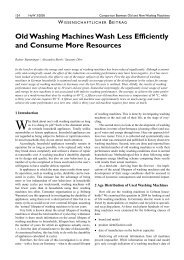Washing-up Behaviour and Techniques in Europe - Institute of ...
Washing-up Behaviour and Techniques in Europe - Institute of ...
Washing-up Behaviour and Techniques in Europe - Institute of ...
You also want an ePaper? Increase the reach of your titles
YUMPU automatically turns print PDFs into web optimized ePapers that Google loves.
031_Stamm<strong>in</strong>ger.qxp 27.02.2007 16:26 Seite 37<br />
<strong>Wash<strong>in</strong>g</strong>-<strong>up</strong> behaviour HuW 1/2007 37<br />
exception that the cleaned cutlery rema<strong>in</strong>s for some time <strong>in</strong><br />
the r<strong>in</strong>s<strong>in</strong>g s<strong>in</strong>k before it is removed batch-wise <strong>and</strong> placed<br />
on the drip pan. Remarkable is the high number <strong>of</strong> water<br />
changes, approximately ten times for the soak<strong>in</strong>g s<strong>in</strong>k <strong>and</strong> a<br />
few lesser times for the r<strong>in</strong>s<strong>in</strong>g s<strong>in</strong>k, always start<strong>in</strong>g with<br />
runn<strong>in</strong>g water.<br />
Observation: The dish wash<strong>in</strong>g process thus practised is<br />
dist<strong>in</strong>guished by an optimized water management <strong>and</strong> a very<br />
systematic procedural approach.<br />
Characterization: Female French, under 40 years <strong>of</strong> age;<br />
total water consumption: 62.8 l; energy consumption:<br />
1.32 kWh; accumulated dish wash<strong>in</strong>g time: 90 m<strong>in</strong>; detergent<br />
consumption: 34 g; clean<strong>in</strong>g <strong>in</strong>dex: 3.88.<br />
Frequency<br />
30<br />
25<br />
20<br />
15<br />
10<br />
5<br />
0<br />
W ISSENSCHAFTLICHER B EITRAG<br />
Figure 1: Histogram <strong>of</strong> total (warm <strong>and</strong> cold) water consumption<br />
0 40 80 120 160 200 240 280 320 360 400 440 480<br />
-20 -60 -100 -140 -180 -220 -260 -300 -340 -380 -420 -460 -500<br />
Source: Own data<br />
Total water [<strong>in</strong> l]<br />
Figure 2: Histogram <strong>of</strong> total amount <strong>of</strong> energy used for all 113 manual washers<br />
Frequency<br />
16<br />
14<br />
12<br />
10<br />
8<br />
6<br />
4<br />
2<br />
0<br />
0.00 0.50 1.00 1.50 2.00 2.50 3.00 3.50 4.00 4.50 5.00 5.50 6.00 6.50 7.00 7.50<br />
-0.25 -0.75 -1.25 -1.75 -2.25 -2.75 -3.25 -3.75 -4.25 -4.75 -5.25 -5.75 -6.25 -6.75 -7.25 -7.75 >8.00<br />
Energy <strong>in</strong> kWh<br />
Source: Own data<br />
Case 9<br />
Practise: The dish wash<strong>in</strong>g procedure <strong>of</strong> this test person<br />
is dist<strong>in</strong>guished by an alternative use <strong>of</strong> s<strong>in</strong>ks. If one s<strong>in</strong>k is<br />
used for clean<strong>in</strong>g, the other s<strong>in</strong>k is utilized for soak<strong>in</strong>g further<br />
dishes. For this both s<strong>in</strong>ks are filled 3/5th to 4/5th with<br />
detergent-enriched water <strong>and</strong> alternatively used. Only for<br />
some plates <strong>and</strong> the cutlery the soak<strong>in</strong>g s<strong>in</strong>k will not serve<br />
simultaneously as the clean<strong>in</strong>g s<strong>in</strong>k but <strong>in</strong> this case only for<br />
pre-clean<strong>in</strong>g followed by f<strong>in</strong>ish-clean<strong>in</strong>g same <strong>in</strong> the other<br />
s<strong>in</strong>k. The cleaned dishes are then without be<strong>in</strong>g r<strong>in</strong>sed <strong>and</strong><br />
not for the purpose <strong>of</strong> drip <strong>of</strong>f either placed on the drip pan<br />
or <strong>in</strong>to the dra<strong>in</strong> basket.<br />
Observation: In spite <strong>of</strong> the rational use <strong>of</strong> both s<strong>in</strong>ks the<br />
test person used relatively much time for do<strong>in</strong>g the dishes<br />
achiev<strong>in</strong>g a merely moderate clean<strong>in</strong>g result.<br />
Characterization: Female British,<br />
under 40 years <strong>of</strong> age; total water consumption:<br />
33.0 l; energy consumption:<br />
1.03 kWh; accumulated dish wash<strong>in</strong>g<br />
time: 78 m<strong>in</strong>; detergent consumption:<br />
21 g; clean<strong>in</strong>g <strong>in</strong>dex: 3.38.<br />
Case 10<br />
Practise: The test person starts with<br />
fill<strong>in</strong>g the left h<strong>and</strong> s<strong>in</strong>k 4/5 th with water,<br />
he adds detergent <strong>and</strong> loads the s<strong>in</strong>k<br />
with sp<strong>in</strong>ach sta<strong>in</strong>ed plates <strong>and</strong> bowls<br />
for soak<strong>in</strong>g same. The right h<strong>and</strong> s<strong>in</strong>k is<br />
filled with clear water. The procedure is<br />
started by clean<strong>in</strong>g the bowls with a<br />
sponge type cloth <strong>and</strong> deposit<strong>in</strong>g them<br />
<strong>in</strong> the right h<strong>and</strong> s<strong>in</strong>k. The plates, however,<br />
are washed <strong>and</strong> r<strong>in</strong>sed under runn<strong>in</strong>g<br />
water thereafter <strong>and</strong> placed on the<br />
drip pan. Afterwards the cutlery is put<br />
<strong>in</strong>to the left h<strong>and</strong> s<strong>in</strong>k, <strong>in</strong>dividually cleaned<br />
<strong>and</strong> deposited <strong>in</strong>to the right h<strong>and</strong><br />
s<strong>in</strong>k. Whilst chang<strong>in</strong>g the water <strong>of</strong> the<br />
left h<strong>and</strong> s<strong>in</strong>k the dishes deposited <strong>in</strong> the<br />
right h<strong>and</strong> s<strong>in</strong>k are removed <strong>and</strong> without<br />
prior drip <strong>of</strong>f immediately towelled dry.<br />
The so<strong>up</strong> plates (deep plates) are soaked<br />
<strong>and</strong> cleaned <strong>in</strong> the mean time <strong>in</strong> the left<br />
h<strong>and</strong> s<strong>in</strong>k. They are placed partly direct<br />
<strong>in</strong>to the dra<strong>in</strong>er basket or <strong>in</strong>to the right<br />
h<strong>and</strong> s<strong>in</strong>k. Soak<strong>in</strong>g <strong>of</strong> further plates,<br />
remov<strong>in</strong>g the plates from the right h<strong>and</strong><br />
s<strong>in</strong>k, dry towell<strong>in</strong>g <strong>of</strong> the plates put<br />
down, clean<strong>in</strong>g <strong>of</strong> further plates are<br />
alternat<strong>in</strong>g work paces, fail<strong>in</strong>g to <strong>in</strong>dicate<br />
a systematic approach. Sta<strong>in</strong>s detected<br />
dur<strong>in</strong>g dry towell<strong>in</strong>g are simply<br />
wiped <strong>of</strong> with the towel. Only once a<br />
plate was returned to the s<strong>in</strong>k for post<br />
clean<strong>in</strong>g. Next to last the glasses are<br />
washed <strong>in</strong> accordance to the same<br />
approach whilst two brushes <strong>and</strong> the





